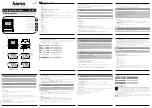
Model 9289
Spectracom Corporation
NetClock/NTP Network Time Provider Instruction Manual
3-22
Figure 3-27: NTP General Screen
Refer to Figure 3-27. The NetClock can operate in unicast mode, broadcast mode, or both.
The user can enable or completely disable the NTP Service. When enabled, the NTP Service
operates in unicast mode. In unicast mode the NTP Service responds to NTP requests only.
The NTP Service supports a broadcast mode in which it sends a NTP time packet to the
network broadcast address. Check the box for NTP Broadcast to enable broadcast mode and
select a rate at which to broadcast from the dropdown box. The NTP Broadcast mode is
intended for 1 or a few servers and many clients. The NTP Broadcast rate should be selected
based upon the network utilization and time drift in the clients. NTP broadcast can utilize MD5
authentication. Select a single MD5 key to use for broadcast from the pulldown menu. Use of
MD5 authentication requires that MD5 symmetrical keys already be defined on the NTP
Symmetrical Keys page. With the NTP service enabled and NTP broadcasting checked, the
NetClock will operate in both modes.
When the NTP service is enabled, the NTP server will “listen” for NTP request messages from
NTP clients on the network. When an NTP request packet is received, the NTP server will send
an NTP response time packet to the requesting client. Under typical conditions, the Spectracom
NTP server can service up to 4,000 NTP requests per second without MD5 encryption enabled
(and a somewhat lower rate with MD5 encryption enabled).
When NTP broadcasting is selected, the NTP server will send unsolicited NTP time packets to
the local broadcast address at a user-selected rate. The rates available are included in the
dropdown menu. The NTP clients can use unicast, broadcast or a combination of both to
discover and synchronize with the NTP server.
The NTP server supports authenticated NTP packets using an MD5 authenticator. This feature
does not encrypt the time packets, but attaches an authenticator, which consists of a key
identifier and an MD5 message digest, to the end of each packet. This can be used to
guarantee that NTP packets came from a valid NTP client or server, and that they were not
tampered with during transmission.
To use the MD5 authentication with trusted key ID, both the NTP client and the NetClock must
contain the same key ID / key string pair and the client must be set to use one of these MD5
pairs. The key ID must be a number between 1 and 65532; the key string must be readable
ASCII and between 1 and 16 characters long. Duplicate key IDs are not permitted. NTP
requests received by the NTP server that do not contain an authenticator containing a valid Key
ID and MD5 message digest pair will be responded to, but no authentication will be performed.
NTP requests with valid authenticator result in a valid NTP response with its own valid
authenticator using the same Key ID provided in the NTP request.
The NTP Access grid on the NTP General screen allows the user to enable or disable all IPv4
and IPv6 requests, as well as to allow or deny users or network segments. Clicking the “Auth
Only” box on each line where a user or network segment is defined will prompt the NetClock to
accept only authenticated requests (MD5 or Autokey) from this user or network segment.
From the NTP References screen (Figure 3-28), the user may check the “Enable Stratum 0
Reference” box. This makes the 9383 a Stratum 1 reference. If this box is not checked, it means
the NetClock is a Statum 2 (or higher) reference.
Summary of Contents for 9289
Page 18: ...Model 9289 Spectracom Corporation NetClock NTP Network Time Provider Instruction Manual 1 8...
Page 36: ...Model 9289 Spectracom Corporation NetClock NTP Network Time Provider Instruction Manual 2 18...
Page 154: ...Model 9289 Spectracom Corporation NetClock NTP Network Time Provider Instruction Manual 3 118...
















































